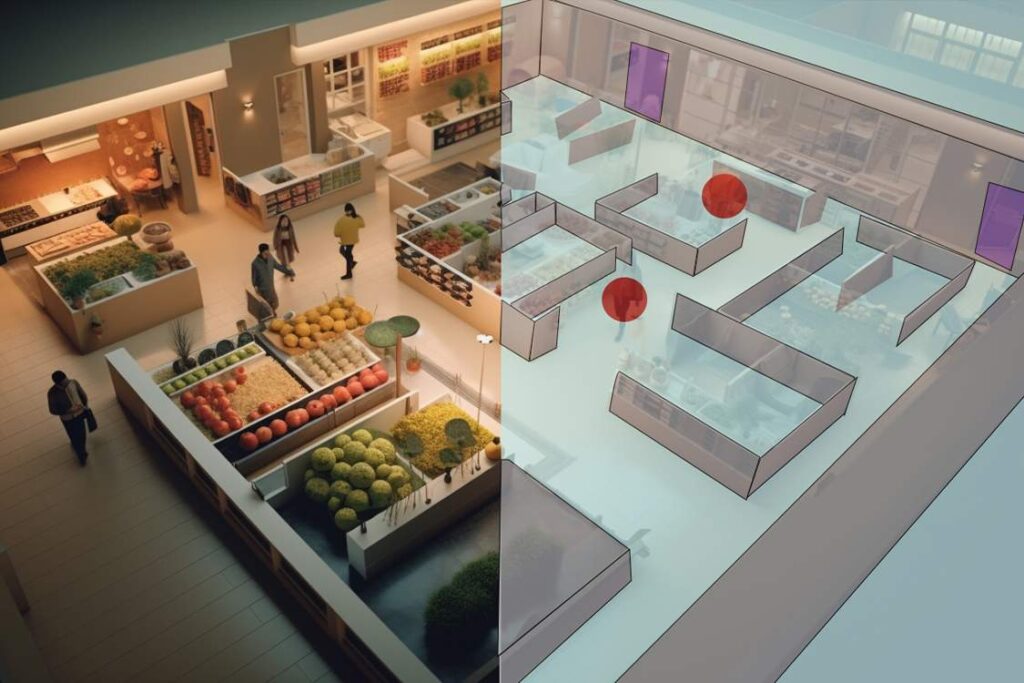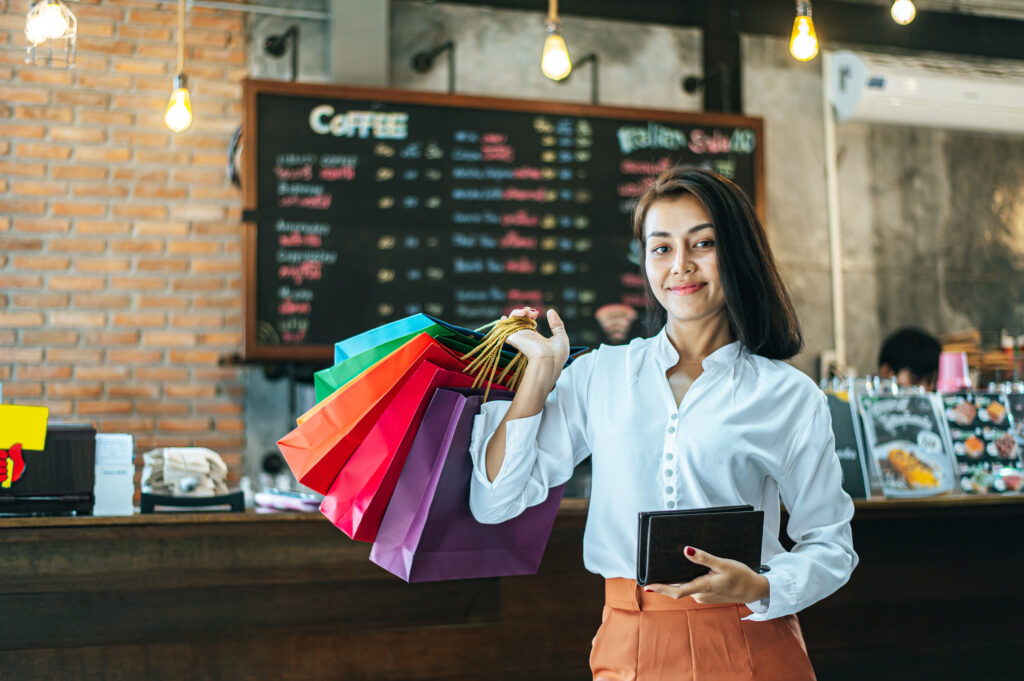SugarXR for Digital Twinning a Retail Store

Digital Twinning
Giving retailers the ability to create an online virtual complete twin of the physical store.
- Enhancing the In Store Experience
- Shopping in the Virtual Twin of a Physical Store
- Virtual Pop-Up Stores in Real-World Spaces
Enhancing the In Store Experience
From optimizing store layouts and managing inventories to enhancing online shopping experiences and achieving sustainability goals, digital twins are proving to be invaluable assets. As more retailers recognize the benefits of this technology, digital twinning is set to become a staple in the retail industry’s future, driving innovation, efficiency, and customer satisfaction.
The Next Frontier
At the heart of digital twinning is the ability to model and understand customer behaviors and preferences in a virtual environment that mirrors the physical store. Retailers can use this insight to optimize store layouts, product placements, and promotional strategies, ensuring that each element is tailored to meet the needs and desires of their customer base. Imagine walking into a store where everything from the lighting to the product assortment is optimized for your comfort and convenience, thanks to insights gleaned from its digital twin.
Personalizing the Shopping Journey
The digital twin technology offers unparalleled opportunities for personalization. Retailers can leverage data from their digital twins to understand customer preferences and behaviors at a granular level, allowing them to tailor the shopping experience to individual needs. From personalized recommendations to augmented reality (AR) fitting rooms, digital twinning enables a level of service and personalization that was once the realm of science fiction.
Facilitating Seamless Omnichannel Experiences
In today’s retail environment, seamless integration between online and offline channels is essential. Digital twins bridge this gap by providing a unified view of the customer’s journey across all touchpoints. This integration enables retailers to offer consistent, personalized experiences whether the customer is shopping online, in-store, or through a mobile app, enhancing customer satisfaction and loyalty.
Streamlining Operations and Inventory Management
Digital twins allow retailers to run simulations and analyses to predict and respond to future scenarios, optimizing operations for efficiency and resilience. By replicating inventory systems in a digital space, retailers can anticipate stock levels, manage supply chains more effectively, and reduce waste. This precise control over inventory not only cuts costs but also ensures that customers find what they need when they need it, significantly improving the shopping experience.
Driving Sustainability in Retail
Sustainability is a pressing concern for consumers and retailers alike. Digital twinning contributes to sustainability efforts by optimizing supply chain logistics and reducing energy consumption through efficient store design and operations. By simulating different scenarios, retailers can identify strategies that minimize their environmental impact, such as reducing overstock or optimizing delivery routes, thereby contributing to a more sustainable future.
Bridging the Online-Offline Gap
Virtual twins represent a significant leap in bridging the gap between online and offline retail. By replicating the physical store experience online, customers can enjoy the best of both worlds. This integration also benefits retailers by providing detailed insights into customer behavior, both online and offline, allowing for more effective inventory management, store layout optimization, and marketing strategies.
Shopping in the Virtual Twin of a Physical Store
Shopping in a virtual twin of a physical store online is not just an innovative concept; it is a glimpse into the future of retail—a future where digital and physical realms merge to create shopping experiences that are engaging, personalized, and convenient. As retailers continue to explore and invest in virtual twins, we can expect to see a transformation in the retail landscape, one that caters to the evolving needs and preferences of consumers in an increasingly digital world.
In an era where technology relentlessly reshapes consumer expectations, the retail industry stands on the brink of a transformative revolution. The advent of virtual twins—a digital mirror of physical stores—promises to merge the tactile allure of in-store shopping with the convenience of online experiences. This fusion not only redefines the boundaries of retail but also offers a glimpse into a future where digital and physical realms coalesce seamlessly.
Let us explore how shopping in a virtual twin of a physical store online is shaping the future of retail, offering unprecedented opportunities for engagement, personalization, and convenience.
The Virtual Twin Experience: A New Paradigm in Shopping
Imagine entering a digital replica of your favorite store from the comfort of your home. This is not just a series of static images or a flat online storefront; it is a fully interactive, three-dimensional environment that replicates the physical store’s layout, product placements, and ambiance. You can navigate through aisles, interact with products, and even consult with virtual assistants or AI-powered avatars for advice and recommendations. This immersive experience is the essence of shopping in a virtual twin, blurring the lines between digital and physical retail spaces.
Enhanced Customer Engagement and Interaction
One of the most compelling benefits of virtual twin shopping is the enhanced level of engagement and interaction it offers. Customers are no longer passive browsers but active participants in a dynamic shopping environment. Retailers can leverage this interaction to offer personalized shopping experiences, live product demonstrations, and interactive events, such as virtual fashion shows or product launches. The result is a deeply engaging and memorable shopping experience that fosters brand loyalty and encourages repeat visits.
Personalization at Its Best
The power of data analytics and AI comes to the forefront in virtual twin shopping, enabling an unprecedented level of personalization. Based on your shopping history, preferences, and even real-time interactions within the virtual store, personalized recommendations and promotions appear as you navigate through the space. This tailored approach not only enhances the shopping experience but also increases the likelihood of purchases by presenting customers with products that truly resonate with their needs and desires.
Convenience Redefined
The convenience of online shopping is elevated in the virtual twin experience. Customers can enjoy the immersive experience of in-store shopping without the constraints of physical distance, store hours, or queues. This 24/7 accessibility ensures that shopping can be done at the customer’s leisure, making it easier than ever to fit into busy lifestyles. Additionally, integrated e-commerce functionality allows for instant purchases, with options for home delivery or in-store pickup, further enhancing the convenience factor.
Virtual Pop-Up Stores in Real-World Spaces
The advent of virtual pop-up stores in real-world spaces marks a significant evolution in retail, offering a myriad of benefits to retailers eager to innovate and connect with consumers in new ways. From cost savings and flexibility to enhanced customer insights and sustainability, the advantages are clear.
As technology continues to advance and consumer expectations shift towards more immersive and interactive shopping experiences, virtual pop-ups stand poised to redefine the retail landscape, offering a glimpse into the future of commerce.
Expand Without the Store
In an era defined by digital innovation and shifting consumer behaviors, retailers are constantly exploring new avenues to captivate audiences and drive engagement. One of the most exciting trends emerging at the intersection of technology and retail is the concept of virtual pop-up stores in real-world spaces. These digital storefronts offer a novel way for brands to interact with consumers, blending the physical and digital worlds to create unique, immersive shopping experiences. Let us delve into the myriad benefits these virtual pop-ups offer retailers, from increased brand visibility to enhanced customer insights.
Novelty and Engagement
The novelty of virtual pop-up stores lies in their ability to surprise and engage consumers in unexpected places, turning everyday environments into interactive shopping experiences. Whether it is a bustling city square or a tranquil park, these virtual stores can pop up anywhere, grabbing the attention of passersby with augmented reality (AR) displays, exclusive digital content, and interactive product demos. This element of surprise not only generates buzz but also encourages social sharing, amplifying brand visibility across digital platforms.
Cost-Effective Expansion
Traditional pop-up stores come with significant costs, including leasing space, designing, and constructing the physical setup, and staffing. Virtual pop-ups, on the other hand, eliminate many of these expenses, allowing retailers to launch innovative campaigns with a fraction of the investment. This cost-effectiveness enables brands to experiment with new markets and locations without the financial risk associated with physical pop-ups, making it an attractive strategy for both established brands and emerging startups.
Flexibility and Scalability
The digital nature of virtual pop-up stores offers unparalleled flexibility and scalability. Retailers can quickly adapt their virtual storefronts to highlight new products, align with seasonal themes, or respond to real-time market trends. This agility ensures that the brand remains relevant and can capitalize on emerging opportunities. Moreover, the scalability of virtual pop-ups means that retailers can simultaneously launch campaigns in multiple locations, both domestically and internationally, without the logistical challenges of physical stores.
Enhanced Customer Insights
Virtual pop-up stores equipped with AR and other interactive technologies provide a treasure trove of data on customer preferences, behaviors, and engagement patterns. By analyzing interactions within these virtual environments, retailers can gain valuable insights into what captivates their audience, which products draw the most interest, and how consumers navigate the buying journey. These insights can inform future marketing strategies, product development, and customer engagement initiatives, driving more personalized and effective retail experiences.
Sustainable Retailing
Sustainability is an increasingly important consideration for both consumers and brands. Virtual pop-up stores offer a more environmentally friendly alternative to traditional retail setups, reducing the need for physical materials, transportation, and energy consumption associated with setting up and operating physical spaces. By embracing virtual pop-ups, retailers can demonstrate their commitment to sustainability, enhancing their brand image and appealing to eco-conscious consumers.
Bridging the Physical-Digital Divide
Virtual pop-up stores represent a unique opportunity to bridge the gap between online and offline retail. By integrating digital experiences into physical spaces, retailers can enhance the customer journey with the convenience and personalization of online shopping, while retaining the tangible, experiential aspects of in-store visits. This comprehensive approach can enhance customer satisfaction, foster brand loyalty, and drive sales both online and offline.
The Future of Retail
As technology advances, the potential for virtual twin shopping experiences grows. With the integration of virtual reality (VR) headsets, the experience will become even more immersive, offering a truly tactile sensation of products. The rise of 5G technology will further enhance these experiences, ensuring smooth, real-time interactions without lag or interruptions.
Digital twinning is not just a technological innovation; it is a strategic tool that can redefine the retail landscape. By providing detailed insights into every aspect of the retail operation and customer experience, digital twins offer a roadmap for retailers to navigate the complexities of the modern retail environment. As this technology continues to evolve and become more accessible, it will undoubtedly play a pivotal role in shaping the future of retail, offering a glimpse into a world where the boundaries between physical and digital are seamlessly blended.
IKEA’s Use of Digital Twins for Store Layout Optimization
IKEA, the Swedish furniture giant, has been at the forefront of adopting digital twinning to optimize store layouts and product placements. By creating digital replicas of their physical stores, IKEA can simulate customer flow and interaction with products. This insight allows them to rearrange layouts and test different configurations before implementing any changes physically. The result is an optimized shopping experience that not only makes it easier for customers to find what they are looking for but also maximizes sales through strategic product placements.
Nike’s Virtual Inventory Management
Nike has leveraged digital twinning to revolutionize its inventory management and product development processes. By creating digital twins of their sneakers and apparel, Nike can analyze performance, design, and wear-and-tear in a virtual environment. This approach enables them to predict inventory needs more accurately, reduce overproduction, and speed up the design process. Additionally, digital twins help Nike create a more interactive and engaging online shopping experience, where customers can see highly detailed, 3D models of products before making a purchase.
Walmart’s Use of Digital Twins for Energy Efficiency
Walmart has employed digital twinning technology to improve energy efficiency across its stores. By creating digital replicas of their physical locations, Walmart can simulate and analyze energy consumption patterns. This allows them to identify inefficiencies and test different strategies to reduce energy use, such as adjusting lighting, heating, and cooling systems. The initiative not only helps Walmart reduce its operational costs but also significantly contributes to its sustainability goals.
Sephora’s Augmented Reality (AR) and Digital Twinning
Sephora, a leader in the beauty retail sector, has embraced digital twinning alongside augmented reality to offer personalized shopping experiences. Their “Virtual Artist” app uses AR technology to allow customers to try on makeup virtually. Behind this AR interface lies a complex digital twinning system that tracks inventory and customer preferences, enabling Sephora to offer personalized recommendations and ensure that popular products are always in stock, both online and in physical stores.
Amazon’s Whole Foods and the Integration of Digital Twins for Supply Chain Optimization
Amazon’s acquisition of Whole Foods marked the beginning of a significant shift towards integrating digital twinning in the grocery sector. By employing digital twins of the Whole Foods supply chain, Amazon can simulate and optimize the flow of goods from suppliers to store shelves. This technology enables them to reduce waste, predict stocking needs more accurately, and enhance the efficiency of deliveries. The goal is to provide customers with fresher products while minimizing supply chain costs and environmental impact.

